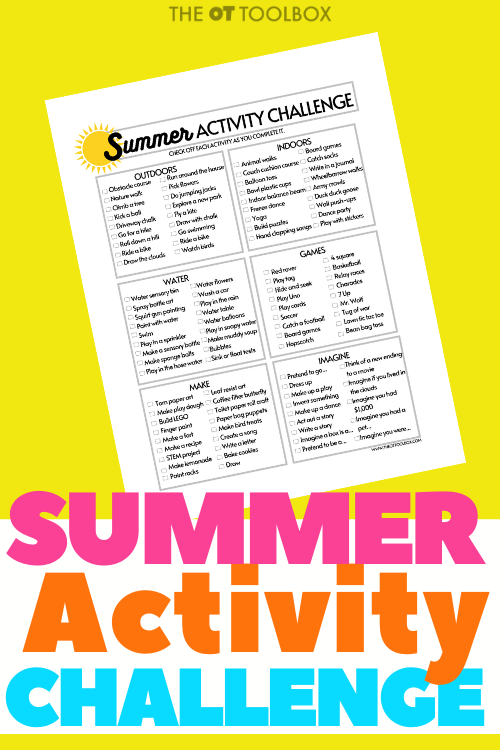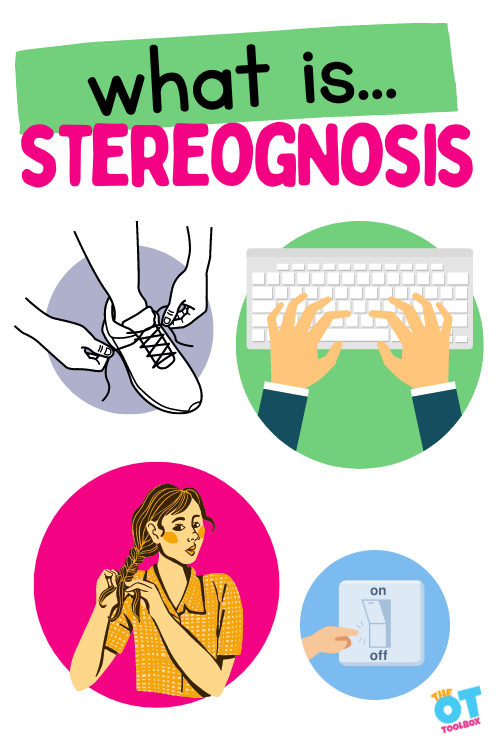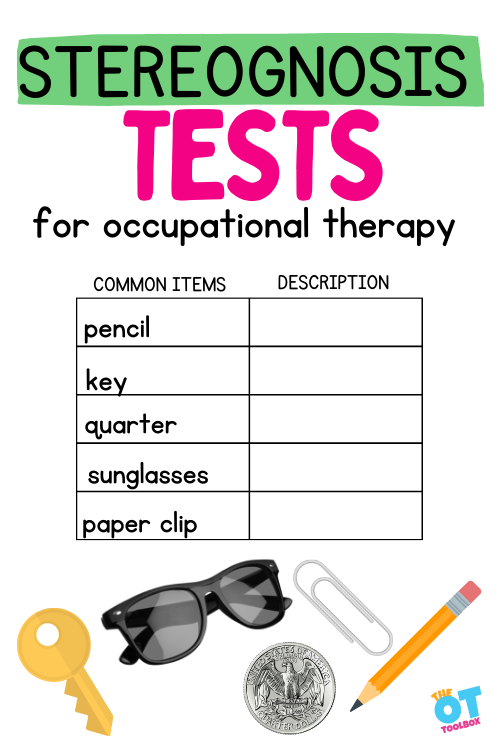These coin activities are fun ways to develop fine motor skills AND functional money skills. The fact is that coin sorting activities and counting coins activities are functional…they are tasks kids need to develop for daily living skills. But, did you ever stop to think about the fine motor benefits of playing with coins? There are a handful! So, grab a handful of coins and use these coin activities to help kids with fine motor skill development!
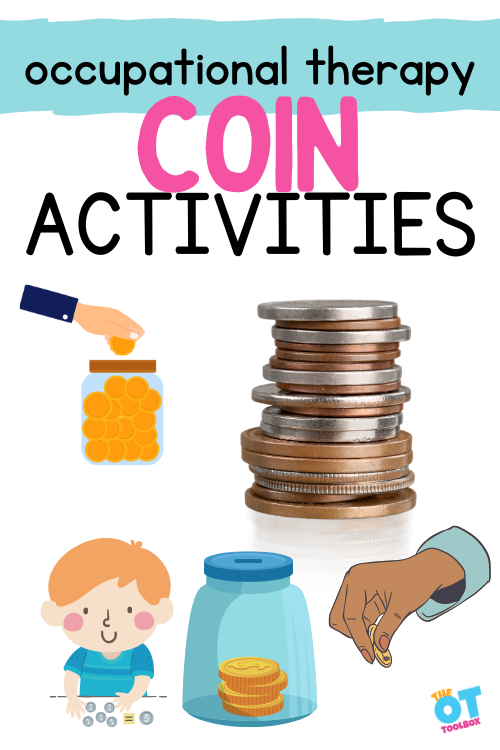
Coin Activities
This is an older blog post on the website, but one that has so many fine motor activities using just coins. You’ll find coin sorting activities, coin rubbing art, money counting skills, and counting coin activities that build math and money skills as well as fine motor skills.
But, I also wanted to go into detail on the various ways kids can use a stack of coins to develop skills needed for fine motor tasks.
You may have seen a previous blog post detailing the use of plastic gold coins to develop fine motor skills…today’s article covers real coins you have in your purse or pocket, and can be used for teaching money to kindergarten or first grade students.
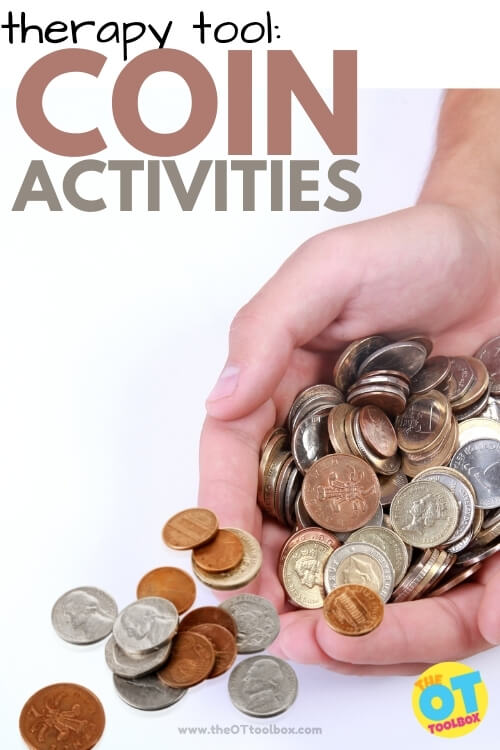
Coin Sorting Activity
A warm-up activity with sorting coins is a nice start to the therapy session because it can help to connect with the child and that they are engaged in the process, using a functional task that is needed for IADLs.
Stack Coins Fine Motor Activity
A nice warm-up to an occupational therapy session is this coin sorting activity: Once we’ve said hello and I have checked in with how my client is doing its time to ‘show me the money’.
Place a pile of coins on the desk, and spend some time sorting coins into piles. I ask the child to show me the coins that match and we discuss what pictures we can see on the coins, what numbers we can see and how much the coins are worth.
Sorting coins is a great task to work on a variety of skills:
- Visual discrimination
- Form constancy
- Size awareness
- Visual closure
- Visual figure-ground
- Visual memory
Sort Coins by Touch
Once we have looked through all our coins I ask the children to place the coins in a pile in front of them and close their eyes. With their eyes closed they must pick a coin and show me which one they have collected.
This activity targets Stereognosis, or the touch awareness related to identifying coins by touch, or by determining the coin by “feel”. When you sort through coins, you can find a quarter vs a penny by feeling the size of the coin.
I have a list of corresponding whole body, gross motor exercises that they must perform depending on the coin they have selected. These exercises will target specific gross motor goals that we are working on.
The gross motor skills addressed with these coin sorting exercises include:
- Core stability
- Shoulder stability
- Balance
- Bilateral coordination
- Posture and positioning changes
- Vestibular input
- Proprioceptive input
- Eye-hand coordination
- Gross motor coordination
Grab this handout by entering your email address into the form at the bottom of this blog post.
Coin Activities for Fine Motor Skills
Once we are all warmed up and feeling focused and attentive, we are ready to work on our fine motor skills. One aspect of money counting skills that can be difficult for children is the fine motor component. These coin activities take into consideration, all of the fine motor skills needed for counting and sorting coins.
In-hand manipulation activities are a great way to boost fine motor skills needed for tasks like managing clothing fasteners, using a pencil when writing, manipulating items like coins or beads, and more.
The dexterity that is worked on when picking up coins from a flat surface is huge! You need to pick up the edges with a tip-to-tip grasp and perform in-hand manipulation to “squirrel away” the coin into the palm of the hand.
In-hand manipulation is moving an object within the hand, without help from the other hand. This resource explains ways to work on in-hand manipulation with coins.
Stacking coins is another great exercise. We put the quarters into piles and counted out dollars. But at the same time, we were working on translation of the coin from the palm of the hand to the tips of the fingers.
Translation is a type of in-hand manipulation that you use when moving an object from the finger tips to the palm and vice versa. Stacking requires a lot of controlled dexterity!
Why are these skills important? Kids need to refine their fine motor skills and in-hand manipulation in order to manipulate the pencil with slight movements while writing, erasing, and coloring.
They need the small motor control to manage fasteners like zippers, snaps, buttons, and shoe tying.
Using coins is a wonderful way to work on so many fine motor skills. You can target selective finger movements, tactile discrimination, in hand manipulation and finger strengthening.
For these fine motor coin counting activities, ask the children to count out a certain number of coins. I have been working with the number range between 10 and 20 depending on the child’s age.
- Use plastic coins to build fine motor skills– This blog post includes a free printable handout detailing coin activities. This is a great home exercise program for parents.
- Count coins. Use these ideas to work on counting money and building fine motor skills. You can also use a paper coin wrapper to count coins.
- Use coins to work on patterns and skip counting, but also finger isolation skills. This blog post includes a free handout to use in skip counting with coins.
- Coin road – line the coins up in a row as quickly as you can using only your right hand. The children enjoy competing with me during this task. Once completed ask them to perform this activity again using their left hand.
- Coin flip – line the coins up in a row. Using only one hand flip each coin over starting at one end and flipping each coin until you reach the end of the row. Work from left to right to reinforce directionality. Repeat with the other hand.
- Coin stack – see how high you can stack your coins. Keeping going (and counting) until your stack falls over.
- Coin grab – using one hand see how many coins you can pick up and keep safe in your hand. Don’t drop any coins while you are collecting.
- Coin counting – this requires a piggy bank or a parent to assist with making a simple money counting receptacle from a cardboard box or recycled container. See you many coins you can count within a time limit.
- Playdough and coins – this activity requires the addition of playdough. Where this is available encourage children to make impressions of their coins with playdough, roll small balls of playdough and build coin sandwiches or roll snakes of playdough and stand coins in the roll to represent the scales.
- Dice and coins – If your child has a dice available try the following activities. Roll the dice and see if you can pick up the number of coins the dice lands on. Roll the dice and set out your coins in the same position as the dots on the dice (re-create the dice number pattern).
- Coin Rolling– Practice rolling the edge of coins on a flat surface using fingers. This activity focuses on finger strength and dexterity.
Coin rubbing art
Coin rubbing art is a fine motor activity with huge benefits that you can add to your math art ideas. Rubbing the textures of coins onto paper builds so many fine motor skills: precision, bilateral coordination, pinch and grip strength, and eye-hand coordination skills.
To make a coin rubbing, you’ll need a few materials:
- A handful of coins
- Paper
- Crayons
- First place the coins on a table. Be sure to place some coins heads side up, and others tails side up. This helps children to identify both sides of the coin.
- Place a piece of paper over the coins.
- Use the side of a crayon to rub the texture of the coin through the paper. The image of the coin will show up on the paper.
Work on holding the coin below the paper without moving the coin (bilateral coordination.
Work on rubbing the crayon at the “just right” level of pressure (proprioceptive input)
Read more about the benefits of coin rubbing art projects in this sight word crayon rubbing activity that we did.
Coin Activities for Visual Perception
An important part of money lesson plans is identifying different images on the coins, to enable counting and money use.
But, visually discriminating between coin size and images can be very difficult for some children. Then consider that each coin has a different “heads” side and a different “tails” side. Then, consider that there are different versions of each coin. In the U.S. for example, each state has it’s own version of the quarter. This can make coin counting very difficult for children with visual perceptual skill challenges.
Visual perception Coin sorting – this is a great way to work on visual discrimination. I ask my children to draw four or five circles on a piece of paper depending on the different denominations of the coins. Then we sort out pile of coins into the different denominations. Each circle is home to a certain denomination of coin.
The coin whole body movement exercises listed in the form below is a fantastic way to work on discriminating between coin differences. Sometimes adding movement to learning is a game changer, and this multi-sensory learning activity is sure to be a hit.
Teaching Money to Children and Pencil control
Finally, the following money activities incorporate the skill of pencil control. Right around kindergarten and first grade level, students are gaining more precision and finger dexterity with pencil control. Why not work on both coin sorting and coin identification AND pencil control for a doubled functional task?
Managing coins may even be a manual dexterity goal because it’s very functional and relevant.
Coin decorating – Ask your child to write their name in large letters and then place coins over each letter to decorate their name. This can be done with individual letters or numbers if you are working on number formation or letter formations.
Coin race track – encourage your child to draw a race track. Use the coin as a car and demonstrate how to drive the car along the track using an individual finger. Each finger can have a turn to drive the car.
Coin rubbings – place a few coins on the table and place a piece of paper over the coins. Rub over the coin with a crayon or pencil to produce the impression of the coin on the page.
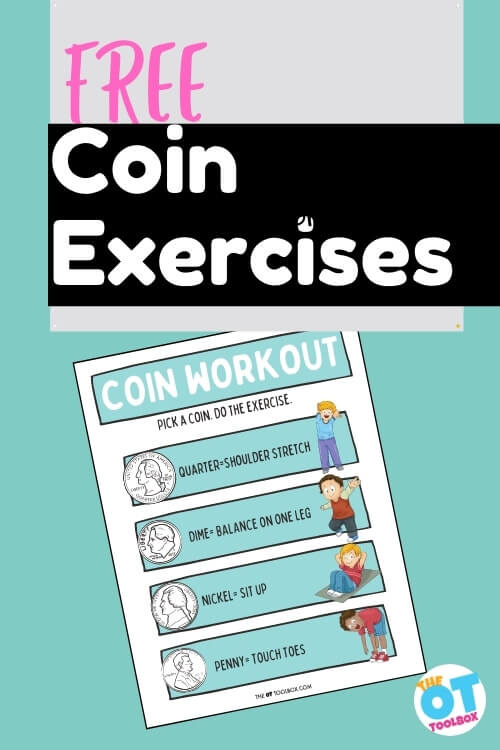
More Activities for a Money Lesson Plan
Occupational therapists know the value of multisensory learning and this list of coin counting and sorting activities are sure to build knowledge and functional skills in children. For a whole-body, movement based resource on learning coins, grab this coin exercise handout.
Be sure to wash hands after manipulating coins! And as always, keep a close eye on your child when coins are part of fine motor play to ensure safety.

Colleen Beck, OTR/L has been an occupational therapist since 2000, working in school-based, hand therapy, outpatient peds, EI, and SNF. Colleen created The OT Toolbox to inspire therapists, teachers, and parents with easy and fun tools to help children thrive. Read her story about going from an OT making $3/hour (after paying for kids’ childcare) to a full-time OT resource creator for millions of readers. Want to collaborate? Send an email to contact@theottoolbox.com.

